On Tom Wootton and Bipolar in Order
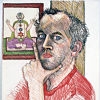
Tom Wootton is an engaging and provocative author and public speaker on the issue of Bipolar Disorder. I listened to him speak in Pasadena, California on September 15, 2010. I found myself totally engaged by the theory he puts forward that Bipolar Disorder can be converted into “Bipolar –In- Order.” This is a state, as I understand it, where self mastery has been achieved and where Bipolar Disorder is converted into a total plus, and the need for medication is eliminated. It is akin to the Buddhist state of enlightenment, where the enormous swings in mood can be allowed without danger to others or oneself. I have found myself pondering the ideas he puts forward and while I find agreement with most of them, I have ultimately come to the conclusion that Tom Wootton’s premise is wrong’ or at least it is wrong for me. If it is wrong for me, I believe it could be wrong for many of the sufferers of the condition, who could be given false hope that life changing – life saving- medication can be abandoned.
Mr. Wootton shows a remarkable diagram, which is an an extension of diagrams by Dr. Allan N. Shore of UCLA, the eminent neuroscientist. (See diagrams attached.) Dr. Shore’s diagrams show the functions of mood as they related to a window of tolerance. In the first diagram fluctuations of mood up and down are within the window of tolerance and represent to kind of swings that a healthy individual experiences. They are neither too high – above the window — nor too low – below the window. In the second diagram the cycle of mood way exceeds the window of tolerance. The ups spike way above this hypothetical window and the lows spike way below. This is the diagram of an unhealthy person, a person with Bipolar Disorder. What the window of tolerance is exactly is not defined. Could this be the zone in which society accepts an individual’s mood swings? Or is it the zone that an individual can experience mood swings without acting out in unacceptable ways? I will posit that this is the zone in which society accepts manic or depressed behavior.
Mr. Wootton takes this second diagram – up and down peaking outside the window of tolerance — and extends it. (See diagram attached.) He extrapolates other states beginning with Crisis – the unbounded state of mood swings — and adds five more states: Managed, Recovery, Freedom, Stability, and Self-mastery. In the Managed, state extreme mood swings have been ameliorated by lower mood swings. They still are outside the window of tolerance. (What is interesting here that Wootton’s diagram does not identify the two lines indicating a zone in the middle of the mood swings). I am going to assume he is referring to the same window of tolerance that was indicated on the Shore Diagrams.) Let us assume that this state is state where intervention has occurred and treatment begun, including the administration of drugs. The managed state is followed by recovery where the mood swings of a bipolar person have been controlled and fall within the limits of tolerance.
Wootton posits that this is an uncomfortable state for an individual suffering from Bipolar Disorder. He terms it the prison of recovery. I think he is right. I experienced the same dissatisfaction. I felt as if I were not myself anymore. Artificial boundaries had been established which I could not break out of. I could no longer experience the high energy that manic person experiences, nor could I feel the sadness that makes us sensitive to life.
I was deadened and slack. This is the feeling that many people with the disorder experience when they are put on medication. They may no longer be suicidal, nor dangerously psychotic, but they are sucked dry of the spark that comes with Bipolar Disorder. (This same feeling of living death can come to those who are depressed only. Discussion of the relationship between Depression and Bipolar Disorder I will leave for future writing.) Given this feeling many persons with Bipolar Disorder decide that medication is not for them and that they should look for another route to resolution. Tom Wootton is offering that route.
In Wootton’s diagram, the limits of toleration disappear in the state of freedom that follows recovery. Freedom from Bipolar Disorder, in Tom’s view, comes through following a program, which he offers in workshops. He has an integrated approach, which starts with an assessment of an individual condition and follows with a life plan for one or two years, and culminates with a treatment plan. This treatment plan is based on three principles: Introspection, Cognitive Recognition, and Meditation. Introspection is developed from mood charts. Mood charts have been used in therapy for a long time. This is nothing new in this approach. Mood charts make individuals aware of the cycle that all bipolar and depressed people experience. Each person’s cycle is different. In my own case I have a six-week cycle between manic and depressed, with two severe extremes each year. One is in September and the other in late January/early February. Others cycle weekly, some daily, and in the case of a doctor I know yearly. Awareness is good and is a good step on a treatment program.
Cognitive Recognition is also a good therapeutic tool. If an individual knows the triggers that can aggravate a cycle, he or she can take steps to avoid the triggers. Stress is one of those great triggers; and stress can be brought on by a whole host of life situations: traffic jams, employment problems, and interpersonal relationships to name but a few of the triggers. My worst trigger is frustration. Frustration constantly arises in my life. I am dyslexic. Number and letter reversals plague me. When my cycle approaches the period of extremes these dyslexic frustrations worsen. Recognition of this frustration trigger does not change it. This problem is organic, but other triggers can be controlled or at least lessened by cognitive recognition and appropriate life style changes. It is difficult to dampen the mood when in full argument with your wife or girlfriend, but it can be done. Exercising, eating right, and adequate sleep are known factors lessening stress. There is nothing new in this cognitive recognition, but it is sound therapy.
Meditation is increasingly understood to have a beneficial effect on mood disorders. Tom Wootton is offering something here that is not a standard part of the therapeutic treatment of mood disorders. He is correct in stating that meditation can lead to states of high focus and to places where the individual is unshaken by life events. However this is where I begin to depart from Mr. Wootton prescription. Nowhere in this outlined treatment plan does he talk about the role of medication. If you are to believe his diagram, Stability and Self-mastery, the final two stages of his program for an individual to become “Bipolar In Order,” can be achieved without drug help. Now I would say this is a miracle, and not that miracles don’t happen, but they are rare. In my view Bipolar Disorder can’t be turned into something else through thinking, experiencing physical sensation – an aspect of meditation, and therapy alone. The problem is organic. The bio-chemical disposition of our brains doesn’t change by awareness or even by life style changes (although healthy eating and exercise help). Just as with my dyslexic condition, which all the awareness in the world won’t change, I am stuck with a brain that bio-chemically works differently. I know this to be true. I feel different when I am manic or depressed. I become a different person. A second self assumes control over my actions that I am powerless to stop. This is not multiple personality disorder – the second self does not obliterate the first self-, nor is hallucinatory. Organic reactions occur. I have deep pains in my brain that spread across my skull in the left hemisphere. No amount of meditation or cognitive recognition will make it go away. It passes in its own time. All I can do is diminish the severity, which I do with medication.
I posit a different diagram for the bipolar condition – I like to call it a condition not a disorder, which implies it, can be made orderly – because it is chronic. I live with it, like I would live if I had epilepsy. (See diagram.) It does not mean I can’t live well, or I have to have a diminished expectation in the world. Here again I think Tom Wootton is absolutely correct. Depression and bipolar can be an advantage. We just have to learn how to moderate it and use it to our best advantage.
My Curve is more complex than Tom Wootton’s Diagram. I see more factors at play. I begin with the crisis situation, but I would have you understand that outside the limits of tolerance are states that grow increasingly worse as one becomes manic or depressed. There are, I believe, four states to mania. I am not sure my titles are the accepted titles – I am not a doctor and my understanding is not clinical. It is experiential. As manic people move out of the boundaries of tolerance, they become wildly happy then super energized. They then move into problem territory. They become angry and enraged and finally psychotic. At it highest point mania can lead to death, either the person’s death or someone else’s. Depression also has states connected with the decline. I call these: mildly unhappy, super sad, isolated and angry, and finally suicidal. At its nadir the depressed person may die. These are severe sequences, not to be trifled with, nor allowed to re-emerge as the individual reaches Wootton’s Self-Mastery, where one could play with death because it supposedly holds no power for the enlightened individual. Buddha I believe would take medication for a chronic condition.
After the crisis of emotion, we move into the sequence of recovery. The moods are dampened and gradually fall within the limits of societal and personal tolerance. This is done with the typical medical response: drugs, psychotherapy, cognitive therapy, etc. Social recovery is an uncomfortable place for most bipolar people. Tom Wootton and I agree on this. It is here that individuals must make choices and advocate for themselves. One option is to end medication gradually and to choose to “ride a bicycle” of a different sort. Tom uses the bicycle analogy to show how one learned as a child to balance and move on two wheels with the assistance of a parent. The individual who follows Tom’s program is at first guided by the hypothetical parent, and then as he or she becomes more skilled can bicycle alone. The parent (coach) is still close by to assist against disaster, but finally the cyclist reaches self-mastery and the role of the coach diminishes or goes away . Tom’s diagram ends the limits of tolerance altogether when the bipolar person declares freedom. He or she has gone beyond the effect of society’s boundaries into a new world few can attain. According to Tom, Gandhi attained this kind of freedom.
Here I disagree and agree with Wootton’s diagram. I agree with his assessment that a bipolar person is trapped in a prison in the typical treatment model. I disagree with him that society’s limits on social behavior can be abandoned or at least disregarded, As bipolar people recover they need to break those psychic boundaries that hold them down within society’s level of tolerance. The swing of their moods will never be within the boundaries because they have too much feeling and too much energy. The feat is to find a medium that allows one to go higher – become a controlled hypomanic person – and go lower – experience sadness fully — without traveling up into the high reaches of anger and rage or sinking into suicidal ideation. This adjustment is best done with medication. Lowering dosages or changing types of medication can often do the deed. A bipolar person can feel 90% himself and happily abandon the extremes of behavior that characterized full blown mania or depression. I don’t believe one can go through any program which does not include a medicine element successfully. Relapse is too great a risk.
What I do believe is that with drug adjustments, and continuation of other rehabilitation factors, an individual can lead a full life and not feel diminished in any way. That is the situation I live with. My medication is adjusted as needed. I am lucky I have a psychiatrist who works with me as a team. If bipolar people are unhappy with the side effects of their medication, they need to self advocate. Fire the unresponsive medical expert and find one who is not just a pill pusher. Tom Wootton seeks the same goals of a purposeful and meaningful life for himself and his clients, but, in my opinion, he appears to be disregarding society boundaries. They exist and they are hard to penetrate. The goal of a managed bipolar person (I say managed, not recovered, because I don’t believe there is recovery which end the bipolar condition) is to change society’s boundaries. Society will never tolerate the extremes of mood behavior, nor do I think it should, but acceptance of a greater diversity below the zenith and above the nadir of mood behavior I think is possible. In my diagram I show the limits of tolerance widened. This can only be done by showing the world what good and productive people are those with managed mood disorders. This would present the eradication of STIGMA. This is when a bipolar person becomes “Bipolar In Order.”

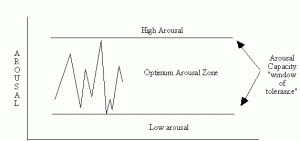
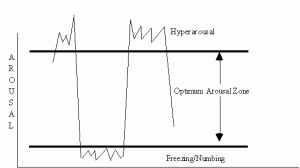
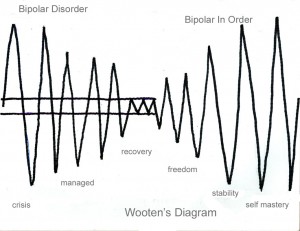
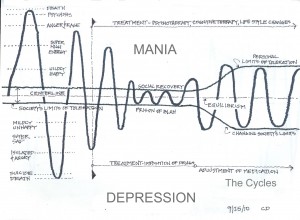




Pingback by Anger Making You Go Mad? - Cypress Holistic Center on 14 November 2012:
[…] for graph – Tim Wooton […]
Comment by maillot manchester united pas cher on 9 March 2014:
I think other web site proprietors should take this site as an model, very clean and magnificent user genial style and design, let alone the content. You are an expert in this topic!
Comment by john cartmill on 4 October 2020:
Hi Carlton, I am a surgeon and have come across your Mania/Depression modification of the Wooten diagram. A colleague, Andrew Gilmore, has drawn my attention to it as a visual metaphor for Dan Siegel’s ‘window of tolerance.’ I would like to use your diagram (duly acknowledged) in a talk I/we are to give called ‘the surgical mind.’
Regards John Cartmill (Sydney, Australia)